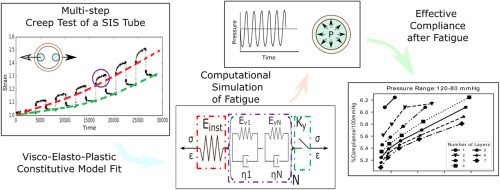Journal of the Mechanical Behavior of Biomedical Materials ( IF 3.3 ) Pub Date : 2018-08-31 , DOI: 10.1016/j.jmbbm.2018.08.044 Paolo Sánchez Puccini , Juan Carlos Briceño Triana

|
In developing new tissue engineered for vascular grafts, the mechanical properties of the material and its evolution once implanted are of utmost importance because they determine the regeneration of the vessel and the blood flow through the conduit. In fact, compliance mismatch is considered the main determinant of graft failure. In this research, we analyze the dynamic properties of the small intestinal submucosa (SIS), and propose and validate a constitutive model to fit the material's behavior. A uniaxial creep and recovery test was performed on SIS tubes to find the constitutive parameters. The model was composed by an elastic element in series with two Kelvin-Voigt solid elements and a plastic slider. The first elastic component was defined using Mooney-Rivlin strain energy function, while the plastic component was defined using a third-degree polynomial function of the plastic stress. The viscoelastic behavior was defined using the creep compliance formulation for the Kelvin-Voigt model. The parameters for the plastic and non-linear elastic elements followed a normal distribution, while the spring and dashpot constants of the visco-elastic element had a linear dependence on the load applied. The constitutive model was then used to simulate the SIS under the geometrical and pressure conditions found in native vessels for 1000 cycles at a frequency of 60 cycles per minute. From the cases simulated, performance curve charts were obtained in terms of the compliance of the material. These curve charts can be used as a predictive tool of the graft's behavior based on its geometry.
中文翻译:

小肠黏膜下层(SIS)的粘弹塑性建模作为血管移植物的应用
在开发为血管移植设计的新组织时,材料的机械性能及其植入后的演变极为重要,因为它们决定了血管的再生和通过导管的血流。实际上,顺应性失配被认为是移植失败的主要决定因素。在这项研究中,我们分析了小肠粘膜下层(SIS)的动态特性,并提出并验证了一种适合材料行为的本构模型。在SIS管上进行了单轴蠕变和恢复测试,以求出本构参数。该模型由与两个Kelvin-Voigt实体元素和一个塑料滑块串联的弹性元素组成。第一个弹性分量是使用Mooney-Rivlin应变能函数定义的,而塑性分量是使用塑性应力的三次多项式函数定义的。粘弹性为Kelvin-Voigt模型使用蠕变柔量公式定义。塑料和非线性弹性元件的参数遵循正态分布,而粘弹性元件的弹簧常数和阻尼常数则与所施加的载荷呈线性关系。然后,本构模型用于在自然容器中发现的几何和压力条件下,以每分钟60个循环的频率模拟SIS,进行1000个循环。从模拟的案例中,获得了根据材料的柔韧性得出的性能曲线图。这些曲线图可以用作基于其几何形状的移植物行为的预测工具。使用Kelvin-Voigt模型的蠕变柔量公式定义粘弹性行为。塑料和非线性弹性元件的参数遵循正态分布,而粘弹性元件的弹簧常数和阻尼常数则与所施加的载荷呈线性关系。然后,本构模型用于在自然容器中发现的几何和压力条件下,以每分钟60个循环的频率模拟SIS,进行1000个循环。从模拟的案例中,获得了根据材料的柔韧性得出的性能曲线图。这些曲线图可以用作基于其几何形状的移植物行为的预测工具。使用Kelvin-Voigt模型的蠕变柔量公式定义粘弹性行为。塑料和非线性弹性元件的参数遵循正态分布,而粘弹性元件的弹簧常数和阻尼常数则与所施加的载荷呈线性关系。然后,本构模型用于在自然容器中发现的几何和压力条件下,以每分钟60个循环的频率模拟SIS,进行1000个循环。从模拟的案例中,获得了根据材料的柔韧性得出的性能曲线图。这些曲线图可以用作基于其几何形状的移植物行为的预测工具。塑料和非线性弹性元件的参数遵循正态分布,而粘弹性元件的弹簧常数和阻尼常数则与所施加的载荷呈线性关系。然后,本构模型用于在自然容器中发现的几何和压力条件下,以每分钟60个循环的频率模拟SIS,进行1000个循环。从模拟的案例中,获得了根据材料的柔韧性得出的性能曲线图。这些曲线图可以用作基于其几何形状的移植物行为的预测工具。塑料和非线性弹性元件的参数遵循正态分布,而粘弹性元件的弹簧常数和阻尼常数则与所施加的载荷呈线性关系。然后,本构模型用于在自然容器中发现的几何和压力条件下,以每分钟60个循环的频率模拟SIS,进行1000个循环。从模拟的案例中,获得了根据材料的柔韧性得出的性能曲线图。这些曲线图可以用作基于其几何形状的移植物行为的预测工具。然后,本构模型用于在自然容器中发现的几何和压力条件下,以每分钟60个循环的频率模拟SIS,进行1000个循环。从模拟的案例中,获得了根据材料的柔韧性得出的性能曲线图。这些曲线图可以用作基于其几何形状的移植物行为的预测工具。然后,本构模型用于在自然容器中发现的几何和压力条件下,以每分钟60个循环的频率模拟SIS,进行1000个循环。从模拟的案例中,获得了根据材料的柔韧性得出的性能曲线图。这些曲线图可以用作基于其几何形状的移植物行为的预测工具。











































 京公网安备 11010802027423号
京公网安备 11010802027423号